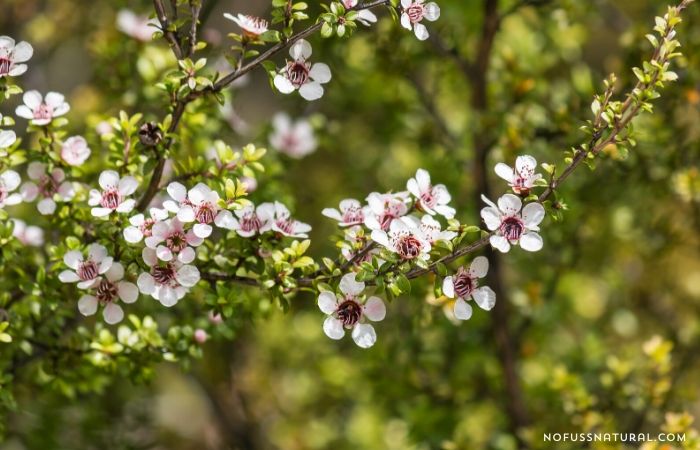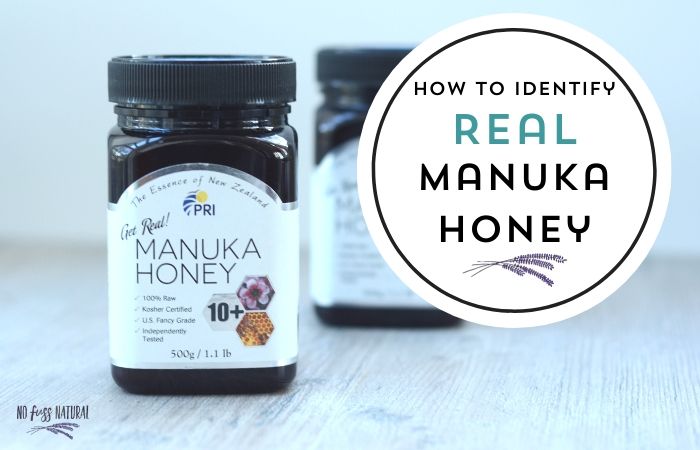What is Manuka Honey?
This article has been reproduced from - No Fuss Natural
With the popularity of Manuka honey on the rise, you may be wondering what all the hype is about it. Some common questions about manuka honey include: What is Manuka honey? What is UMF and non-UMF? How is Manuka different than regular honey?
In this article we take a deep dive into the facts and find the answers to these questions and more.
What is Manuka Honey?
Manuka honey is produced by bees who pollinate the Manuka tree (Leptospermum scoparium). This tree is native to Australia and New Zealand.
It’s distinct flavor makes this honey a delicious addition to many foods and beverages, however, it is also used medicinally, both internally and externally. (Source)
Manuka honey has unique properties not found in any other type of honey known as NPA (non -peroxide activity), which make it useful in supporting the body in various ways. Many consume it daily to promote general well-being and also utilize its antibacterial powers to dress minor wounds and burns. (Source)
To learn more about the scientific definition (and composition) of New Zealand Manuka Honey, check out this graphic from the New Zealand Ministry for Primary Industries.
 Manuka tree in bloom
Manuka tree in bloom
How is Manuka Honey Different to Regular Honey?
Honey, in general, is known to have antibacterial and antibiotic qualities. This is due to the naturally occurring hydrogen peroxide. Unfortunately, these properties are fairly short lived when used internally or externally as the body’s natural defenses convert the hydrogen peroxide to water and oxygen by an enzyme called catalase.
However, Manuka honey has additional non-peroxide activity (NPA) which comes from an organic compound called methylglyoxal (MGO) and two others, dihydroxyacetone (DHA) and 5-hydroxymethylfurfural (HMF) .
This compound is the “active” component of Manuka honey and is not deactivated by the human body.
“MG(O) comes from the conversion of another compound, dihydroxyacetone, that is found in high concentration in the nectar of manuka flowers.” (Source)
No other honey has such high levels of methylglyoxal. This makes Manuka honey the most active and beneficial honey available today.
However, it should be noted that not all Manuka honey is created equal. There are varying levels of activity among batches. Honey must contain high levels of methylglyoxal in order to be considered Real Manuka honey.
UMF vs Non-UMF Manuka Honey

What is UMF?
UMF stands for Unique Manuka Honey Factor. It is “a grading system developed by the UMF Honey Association in New Zealand.” It is a privately funded club. (Source)
According to the new rules laid out by MPI, UMF can only be used as a purity grade not an activity grade.
Manuka honey needs to have a high presence of DHA (dihydroxyacetone), MG (Methylglyoxal), and Leptosperin to be graded a UMF Manuka Honey.
The UMF Honey Association will grant a license to a company's product if it is tested and found to meet the specific UMF standards. Those companies may display the UMF label on their products. This added Logo does add more costs to the end product and should include the MG level on the label for activity identity.
Click here to learn more about the UMF grading system.
What about Non-UMF?
Non-UMF Manuka honey is Manuka honey produced by quality beekepers that do not wish to pay the high costs of joining the UMFHA. This does not mean it is a poor quality honey but should always have a MG rating to ensure activity.
First, all Manuka honey should be independently tested to confirm the levels of MGO present.
In fact, the New Zealand Ministry for Primary Industries states, “honey labelled as mānuka for export must be tested by an MPI-recognised laboratory to make sure it meets the new mānuka honey definition.
The mānuka honey definition is made up of a combination of 5 attributes (4 chemicals from nectar and 1 DNA marker from mānuka pollen).” (Source)
Learn more about these five attributes here.
Both MGO and UMF are Manuka honey grading systems that measure the methylglyoxal content of the honey.
In New Zealand, only certain MPI-recognised laboratories are allowed to test mānuka honey. All Manuka honey imported from NZ, even without the UMF label, should have been tested in one of these labs. (Source)
To ensure the manuka honey you purchase is genuine, always check to see if it has been tested and look for the MG rating. Also, that the supplier is willing to provide an independent COA to match the batch number on the product purchased,
What about Pollen Tests and K factors?
While these are interesting, pollen tests and K factors do not show the medicinal quality of manuka honey. Neither of these tests are indicative of the activity present in the honey.
So, while something like “K-Factor 16” sounds pretty legitimate, it’s not telling you anything about the MGO content and antibacterial ability of the product.
Where to Find High-Quality Manuka Honey
The first step is to find a transparent company. It is important for companies that produce and/or sell Manuka honey to be open about where the honey is sourced as well as the levels of MG.
After all, if the levels of MGO aren’t high-enough, it’s really no better than regular honey.
The company I have had the most experience with regarding Manuka honey is Pacific Resources International (known as PRI). Not only have I found their honey to be extremely delicious, the company itself is incredibly transparent.
PRI provides a full Certificate of Analysis (COA) showing the DHA, MG and UMF levels for every jar of honey they carry.
Simply send the batch number (find it on the label) and they will provide the Certificate of Analysis for that specific batch of honey. Pretty awesome, right?
PRI sells UMF Manuka honey as well independently tested Manuka honey. I have quite honestly never used any honey that remotely compares to the honey I get from PRI. It is quite amazing (Honestly, I make my local friends taste it to show them how awesome it is!).
The company was founded in 1987 by David Noll and was the first to introduce Manuka Honey to the U.S.
Their honey is sourced and packed by family-owned beekeepers and is compliant with Manuka Honey standards set by the New Zealand Ministry for Primary Industries.
They carry a wide variety of honey as well as many Manuka Honey products including Caramels, Chocolates, Nuggets, Cough syrups, and Lozenges.
Click here to visit PRI and learn more about their high-quality Manuka honey.
REFERENCES
Ministry for Primary Industries. (2019, March 28). Mānuka honey. Retrieved November 1, 19AD, from https://www.mpi.govt.nz/growing-and-harvesting/honey-and-bees/manuka-honey/
Miguel, M. G., Antunes, M. D., & Faleiro, M. L. (2017). Honey as a Complementary Medicine. Integrative medicine insights, 12, 1178633717702869. doi:10.1177/1178633717702869
https://www.ncbi.nlm.nih.gov/pmc/articles/PMC5406168/
Who We Are. (n.d.), U Retrieved from https://www.umf.org.nz/who-we-are/.
Molan, P., & Rhodes, T. (2015, June). Honey: A Biologic Wound Dressing. Retrieved November 1, 2019, from https://www.ncbi.nlm.nih.gov/pubmed/26061489.
Ratini, M. (2018, October 8). Manuka Honey: Medicinal Uses, Benefits, and Side Effects. Retrieved November 1, 2019, from https://www.webmd.com/a-to-z-guides/manuka-honey-medicinal-uses#1.
Article taken from No Fuss Natural - What is Manuka Honey